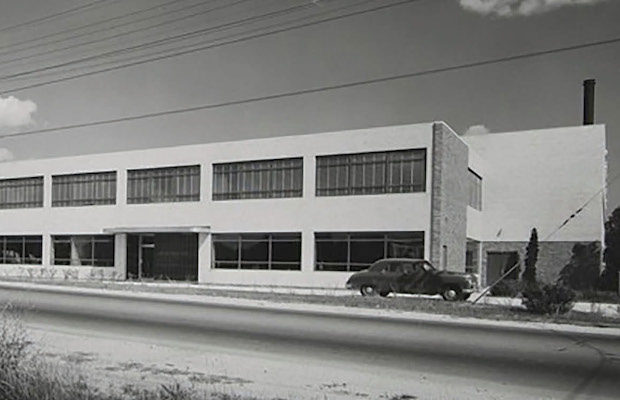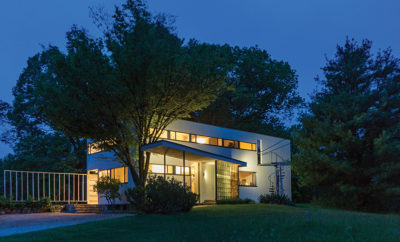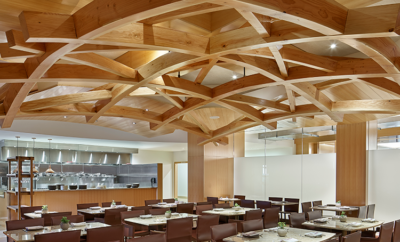 HARVARD ART MUSEUMS/BUSCH-REISINGER MUSEUM, GIFT OF ISE GROPIUS
HARVARD ART MUSEUMS/BUSCH-REISINGER MUSEUM, GIFT OF ISE GROPIUS
Architecture
Gropius in Greensboro
THERE’S A MYSTERY WRAPPED in an enigmatic brick factory in the red clay Piedmont region of central North Carolina. Built between 1944 and 1946, the factory in Greensboro was commissioned by the Container Corporation of America (CCA). A plaque mounted on the entrance reads, “Designed by Walter Gropius, 1944.” Despite the building’s association with the Bauhaus icon, it has gone relatively unnoticed and little researched in the seven decades since it was completed, largely, no doubt, because it’s still a functioning commercial building in an industrial neighborhood off anyone’s beaten path. Although Gropius had a direct role in the design of the building, the attribution appears to be more complex and his involvement more personal than that simple plaque would have you believe.

A rendering by Walter Gropius of the Container Corporation of America’s Office Unit and Factory Building, in Greensboro, North Carolina, 1944–1946. HARVARD ART MUSEUMS/BUSCH-REISINGER MUSEUM, GIFT OF WALTER GROPIUS/IMAGING DEPARTMENT PHOTO © PRESIDENT AND FELLOWS OF HARVARD COLLEGE
Gropius is known foremost as a theorist, educator, and founder of the Bauhaus in Germany. Direct attribution to him as an architect can be tricky since he practiced what he preached—collaboration. His landmark Fagus Factory in Alfeld (1911) was designed with Adolf Meyer; the Bauhaus building (1925–1926), with Carl Fieger and Ernst Neufert. The names of other architects he worked with tended to drop away as Gropius’s fame grew. In 1937 he moved to the United States to teach at Harvard and also formed a private practice with Marcel Breuer. Even his own house in Lincoln, Massachusetts (1938), was co-designed with Breuer.
David Fixler, a preservation architect and expert on modern architecture who has described Gropius as the “single orthodox symbol of the arc of the Modern Movement from 1911–1969,” says he believes that in his later career Gropius “acted more as an art director than principal designer” on many of the buildings he’s associated with. And Fixler is in a position to know. One of his first jobs was as the archivist for Gropius’s last firm, The Architects Collaborative (TAC), during the period when Ise Gropius, Walter’s widow, was assembling her husband’s papers for archives at Harvard and the former Bauhaus. Most of the drawings for the CCA building, now in Harvard’s Busch-Reisinger Museum, bear only Gropius’s seal or name as the architect, but on the final rendering of a somewhat altered design he is credited as “consultant” architect to the Ballinger Company, Architects & Engineers, so his exact authorship remains unclear.

Weakness into Strength is one of a number of posters that famed Bauhaus graphic designer Herbert Bayer created for the CCA’s Early Series campaign, 1941. SMITHSONIAN AMERICAN ART MUSEUM, WASHINGTON, D. C. / ART RESOURCE, NY
By the time he was working on the CCA project Gropius had split with Breuer (in 1941) but had not yet formed TAC (in 1945). In the period between he was working with Konrad Wachsmann on the development of a new panel system for pre-fab housing. Although the CCA factory is International style in its massing, the choice of materials, ribbon windows, and use of color seem like a throwback to Gropius’s earlier years.
Under his direction, the Bauhaus had espoused the application of its design principles at all levels, from architecture to typography and everything in between. The CCA commission offered a similar approach. The Chicago-based firm was owned by Gropius’s friend Walter Paepcke, the son of a German immigrant father and a kindred spirit in the belief that the humanistic ideals of high art and the functionality of industrial production, when merged, could elevate the human condition. The factory building as a type was the fundamental form through which the socially progressive ideology of the Bauhaus could play out in counterpoint to a half- century of wars and wartime production dedicated to destruction.

Bayer’s poster for the Great Ideas series, 1951, reflects the increasing use of color in CCA’s images, which also perhaps played a role in Gropius’s decision to integrate color into the facade of the Greensboro building. SMITHSONIAN AMERICAN ART MUSEUM, WASHINGTON, D. C. / ART RESOURCE, NY
As artists in the European avant-garde had fled to the United States in the prewar years, many found work through Paepcke, who, with his wife Elizabeth, gave financial support to the New Bauhaus school in Chicago, run by former Bauhaus photographer and graphic artist László Moholy-Nagy.
During this period Paepcke also began to think about creating a new image for his company. In 1935 he hired Egbert Jacobson as director of design. A leading graphic designer, Jacobson had introduced German chemist Wilhelm Ostwald’s color theories, which had been an important influence at the Bauhaus, to an American audience. Jacobson had also worked at the innovative advertising company N. W. Ayers & Son, and brought in Ayers’s art director, Charles T. Coiner, to help develop the CCA ad campaign. According to Neil Harris, the author of the catalogue essay for the 1985 exhibition Art, Design and the Modern Corporation: The Collection of Container Corporation of America, A Gift to the National Museum of American Art, modernism had been making inroads in American advertising since the 1920s, but the CCA’s program “represented something of a new start.” Paepcke’s contribution was the idea that the product was superfluous in advertising content. As he told Coiner, “I want to give people the idea that our company is a new and progressive, modern operation. And I don’t need a lot of text . . . you can do it with art.”

Metal printing plates from some of the original CCA ads still hang in the lobby of the former CCA building. MICHAEL CARLEBACH PHOTO
The first ads produced by CCA comprised a series of posters in 1937 by the Russian artist A. M. Cassandre that ran in business publications such as Fortune. That campaign was followed by a succession of others based on different themes—including the war effort beginning in 1942, the United Nations in 1944, and the United States in 1946. The posters for the first campaign were produced in black and white due to the limited advertising budget of a then relatively small company. The wartime posters went to two-color, and the successive campaigns were in full color and widely published. Herbert Bayer, the former star graphic designer and typographer at the Bauhaus, started designing for CCA not long after arriving in the United States in 1938 and became a consultant in 1946, heading the most famous and influential of the firm’s campaigns, “The Great Ideas of Western Man,” which ran from 1950 until 1975. Among the famous artists commissioned to create works for CCA’s various campaigns were Fernand Léger, Man Ray, György Kepes, Ben Shahn, Miguel Covarrubias, Henry Moore, Willem de Kooning, Jean Carlu, René Magritte, and many more.

A 1946 photograph of the CCA Office Unit and Factory Building, which is still in use as a commercial building today. HARVARD ART MUSEUMS/BUSCH-REISINGER MUSEUM, GIFT OF ISE GROPIUS
Inside CCA, Egbert Jacobson was bringing a sophisticated level of design to every aspect of production, raising the intriguing question of whether he might have collaborated with Gropius’s design team on the building. According to Harris, during his tenure at CCA, Jacobson “redesigned everything from its logo to its delivery trucks . . . . Its sales offices and showrooms [were] models of modernism; its factory interiors were replanned with special attention given to the use of color.” Jacobson had published his Color Harmony Manual, developed at CCA’s color laboratories, in 1942, and the 1944 United Nations campaign was the first to go to four-color. Given how integral the use of color was becoming to CCA’s image, it would have been consistent with Gropius’s method of teamwork to consult Jacobson on the color scheme for the new building. After all, by the time the Greensboro factory was being designed and built, the International style was stripping color from buildings. The use of reds and yellows in the building’s materials was counter to the prevailing trend and more akin to the idea espoused by Gropius at the Bauhaus that color should be treated as a medium.
That’s all conjecture though. There are more questions than answers about the design history of the CCA factory at this point. So, note to any architectural history graduate student looking for a dissertation topic—Greensboro awaits you.












